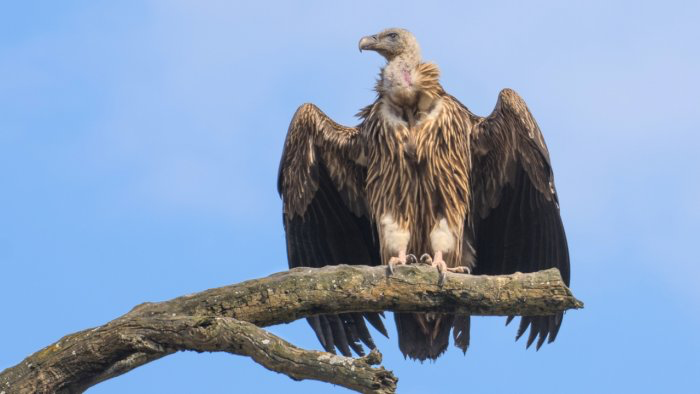Description

Disclaimer: Copyright infringement not intended
Context
- Assam Zoo scripts India's first captive breeding success of Himalayan Vultures.
- The "success story," which was published in the latest edition of Journal of the Threatened Species, according to the journal the successful captive breeding was recorded in March last year inside a display aviary in the zoo, where the birds constructed a nest on the ground and laid an egg.
Details
- After poisoning incidents and accidents way back in 2011-2012, veterinarians were skeptical about the survival of the high-altitude bird species in the state's hot and humid weather.
- The nestling was hand reared in temperature and humidity-controlled boxes and air-conditioned room. It was fed on goat meat and bone pieces and the consumption records maintained. The records of weight gain and body growth were maintained.
- It was a daunting task to breed this species in Guwahati as this species breeds only in snow clad mountains.

Himalayan Vultures
- TheHimalayan vulture (Gyps himalayensis) or Himalayan griffon vulture is an Old World vulture native to the Himalayas and the adjoining Tibetan Plateau
- It is one of the two largest Old World vultures and trueraptors
- IUCN’s red list of threatened species categorised Himalayan Vulture as ‘Near Threatened’.
Features/Characteristics
- The Himalayan Griffon happens to be one of the burliest birds native to the Himalayas and Tibetan plateau.
- With striking bald white heads and broad hefty wings, it is the largest member of the Gyps species (which contains different vulture species).
- The giant vulture weighs between 8-12 kg, has 95-130 cm body length and can fly at an elevation of up to 5,500 metres.
- They live up to 40-45 years of age.
- Himalayan vultures are diurnal and mostly solitary.
- They eat only dead animals, gathering around carcasses that they find when gliding and soaring over large areas.
- They are usually sedentary, moving only altitudinally. Some young birds travel to the low plains in northern India.
- Himalayan vultures are monogamous and pairs return to the same nesting and roosting sites from year to year.
Habitat and Distribution
- The Himalayan vulture mostly lives the Himalayas on the Tibetan plateau (India, Nepal and Bhutan, central China and Mongolia) and is also found in the Central Asian mountains (from Kazakhstan and Afghanistan in the west to western China and Mongolia in the east).
- Occasionally it migrates to northern India but migration usually only occurs altitudinally. Breeding is typically at elevations of 600 to 4,500 m.
- Non-breeding migrants including juvenile birds usually spend the boreal winter near the southern tip of their range, in the lowland plains just to the south of the Himalayas.
Threats
NSAIDS as major threat to vultures in India:
- The rampant use of the three non-steroidal anti-inflammatory drugs (NSAIDS) threatens to undo the Centre’s two decades of work to arrest the dwindling vulture population in the wild.
- The three drugs—aeclofenac, ketoprofen and nimesulide—were introduced as alternatives to diclofenac, that India banned in 2006 for animal use because it caused widespread vulture deaths.
- The country’s vulture population crashed from over 40,000 in 2003 to 18,645 in 2015, as per the last vulture census conducted by intergovernmental body Bird Life International.
- India’s vulture conservation action plan for 2020-25 recommendsa ban on the veterinary use of the three drugs.
- India is also a signatory to the Convention on Migratory Species’ Multi-species Action Plan to Conserve African-Eurasian Vultures, which erecognises NSAIDS as a major threat to vultures in India.
- The vulture action plan recommends meloxicam over diclofenac. Tolfenamic acid isthe other safe option.
Diclofenac:
- Diclofenac, a drug used to treat cattle, was linked to kidney failure in vultures and a decline in the bird’s population.
- Though the drug was banned in 2006, it is reportedly still available for use.
- Diclofenac, that are potentially toxic to vultures being used by vets for treating cattle. The drugs make their way into the vulture’s system as they feed on carcasses.
- Three of India’s vulture species of the genus ‘Gyps’— the long-billed (Gyps indicus) and the slender-billed (G. tenuirostris) had declined by 97%, while in the white-rumped (G. bengalensis) declined nearly 99% between 1992 and 2007.
Habitat Loss:
- Habitat loss is a significant threat to Himalayan vultures. Due to deforestation, urbanization, and human activities encroaching on their natural habitats, vultures are facing challenges in finding suitable nesting and foraging grounds
- Additionally, disturbances at nesting sites and collisions with power lines also posed risks to their populations.
Why vultures are important to protect nature?
- Vultures, as carcass feeders, hold the key for a natural mechanism of infection control.
- Vultures are the scavengers who do the work of cleaning up, and keeping the ecosystem healthy. The beauty is, despite feeding on infected carcass, vultures do not get infected.
- The acids in their stomach are potent enough to kill the pathogen. Thus, the chain of infection is broken. It invisibly controls the spread of harmful pathogens causing deadly anthrax, cholera, foot and mouth disease, rabies and distemper.
- The birds also prevent the contamination of water sources, especially in the wild.
- When animals die near watering hole, there is an imminent danger of contamination resulting in a quick spread of infections and mass death.
- But vultures devour the carcasses in totality thereby preventing a tragic mishap.
‘Action Plan for Vulture Conservation 2020-25’
- It proposes to establish Vulture Conservation Breeding Centres in Uttar Pradesh, Tripura, Maharashtra, Karnataka and Tamil Nadu.
- There would also be a conservation breeding programme for the Red Headed vulture and Egyptian vulture, and at least one “Vulture Safe Zone” in every State for the conservation of the remnant populations.
- There would be four rescue centres in different geographical areas:
- Pinjore in north India,
- Bhopal in central India,
- Guwahati in northeast India and
- Hyderabad in south India, as well as regular surveys to track population numbers, the plan envisages.
|
PRACTICE QUESTION
Q. Which bird species plays a crucial role in the ecosystem by scavenging on carcasses, helping to prevent the spread of diseases, and is currently facing conservation challenges due to a decline in its population in the Himalayan region?
a) Himalayan Eagle
b) Himalayan Vulture
c) Himalayan Owl
d) Himalayan Falcon
Answer: (B)
|

https://www.deccanherald.com/national/east-and-northeast/rescued-himalayan-vultures-script-indias-first-captive-breeding-success-story-in-assam-zoo-1242902.html












